The ocean depths hold secrets that stretch back millions of years, long before humans walked the Earth. Among the most awe-inspiring and terrifying of these ancient secrets are the prehistoric sharks. These weren’t just bigger versions of the Great White; they were a diverse and often bizarre collection of apex predators that ruled the seas with unmatched power. This guide will take you on a journey into the deep past to meet them.
From the colossal Megalodon, a shark that could swallow a car, to the strange Helicoprion with its spiral of teeth, the story of ancient sharks is a tale of evolutionary marvels. We will explore how they lived, how they hunted, and what made them some of the most successful predators in our planet’s history. Prepare to discover a world far more alien and fascinating than you ever imagined.
Table of Contents
Don’t Miss This!
After reading, challenge yourself with our interactive quiz at the end. Click here to take the Quiz
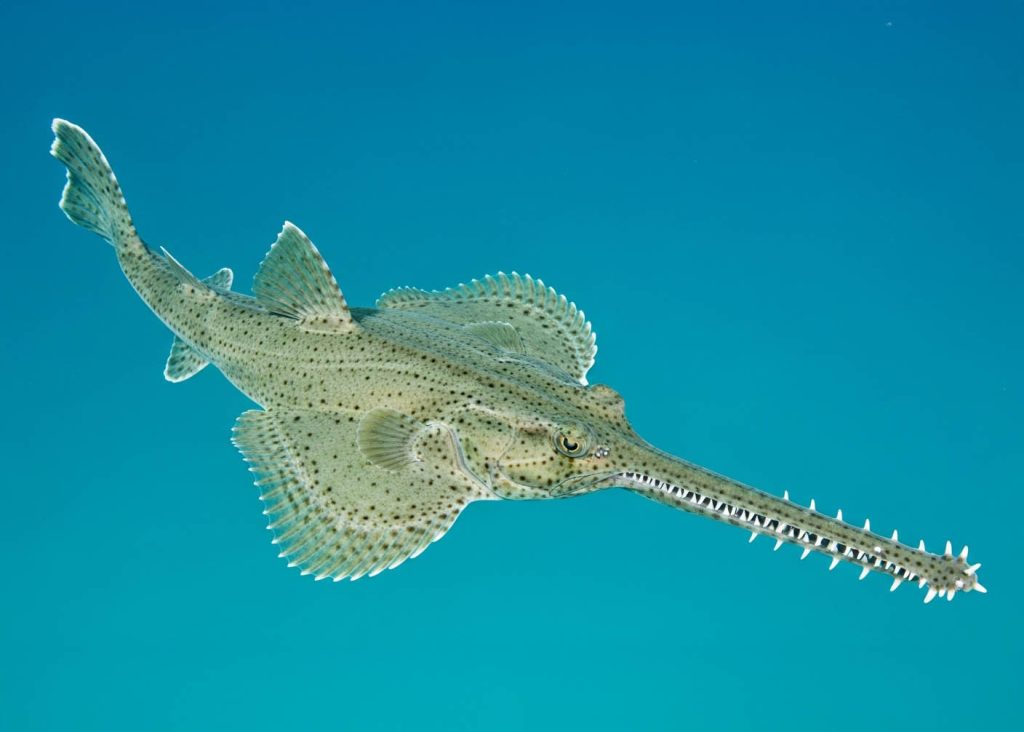
What Exactly Are Prehistoric Sharks?
Before we dive into the giants and the weirdos, let’s clarify what we mean by “prehistoric sharks.” Sharks are an incredibly ancient group of fish, with the first true sharks appearing in the fossil record over 420 million years ago. This means sharks are older than trees, older than the dinosaurs, and have survived multiple mass extinction events.
Unlike bony fish, a shark’s skeleton is made of cartilage, the same flexible material in your ears and nose. Cartilage rarely fossilizes, which is why the fossil record of sharks is dominated by one thing: their teeth. A single shark can produce tens of thousands of teeth in its lifetime, and these hard, enamel-coated fossils are our primary window into their ancient world.
By studying these teeth—their size, shape, and wear patterns—along with rare fossilized vertebrae or fin impressions, paleontologists can reconstruct the lives of these incredible animals. They can estimate their size, figure out their diet, and piece together the story of their evolution. Every fossil tooth tells a part of this epic tale.
The Reign of Giants: Meet the Megalodon
No discussion of prehistoric sharks is complete without paying respects to the king: Otodus megalodon. Megalodon was not just a shark; it was the largest and most powerful predatory fish that ever lived. It cruised the world’s oceans from about 23 to 3.6 million years ago, a true apex predator that sat at the top of the food chain.
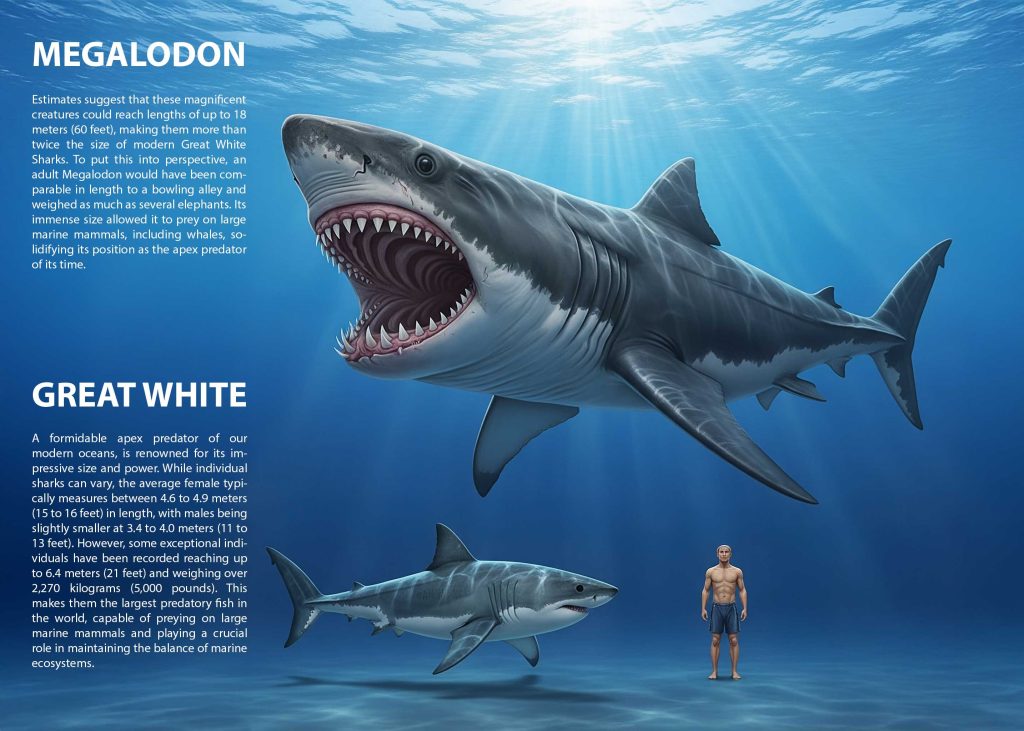
Estimates based on its massive, hand-sized teeth suggest Megalodon could reach lengths of up to 60 feet (18 meters), with some larger estimates suggesting over 80 feet. To put that in perspective, that’s three times longer than the largest Great White Shark. Its jaws could open wide enough to swallow two adult humans side-by-side, and it had a bite force estimated to be one of the most powerful in the animal kingdom, capable of crushing a whale’s skull.
“Imagine a predator that actively hunted and ate the bus-sized whales of its time. That was the reality of Megalodon. It was a force of nature, a shark of almost mythical proportions that was very, very real.”
Megalodon’s diet consisted mainly of large marine mammals, such as the ancestors of modern baleen whales, dolphins, and giant sea turtles. Fossilized whale bones have been found with clear bite marks from Megalodon’s serrated teeth, giving us a chilling glimpse into the brutal predator-prey dynamics of the ancient oceans. Its extinction is thought to be linked to a cooling climate and the disappearance of its primary food sources.
The Buzzsaw Shark: Helicoprion
If Megalodon represents the sheer power of prehistoric sharks, Helicoprion represents the sheer weirdness. Living around 290 million years ago, this shark is famous for its bizarre and unique “tooth whorl.” For decades, paleontologists were baffled by these fossils, which looked like a spiral-bound saw blade made of teeth.
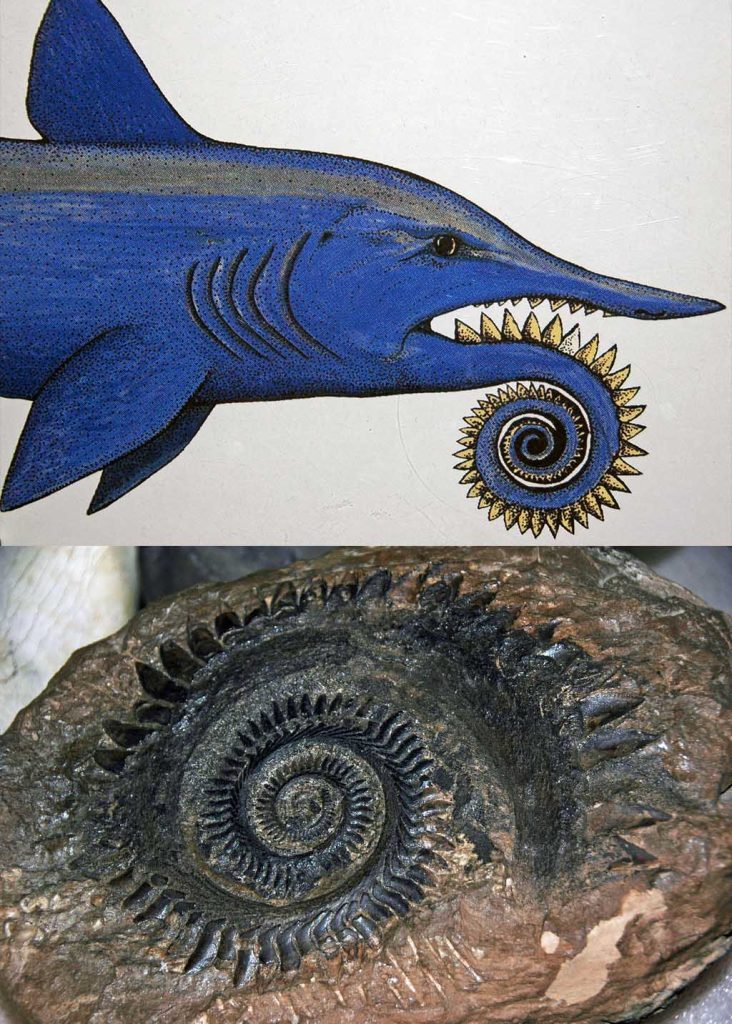
Early reconstructions placed the tooth whorl in all sorts of strange places: on the dorsal fin, the tail, or curling out from the upper jaw. However, modern CT scans of a rare skull fossil revealed the truth. The tooth whorl was situated in the lower jaw, with new teeth forming in the back and pushing the older, smaller teeth forward into the center of the spiral.
Scientists now believe Helicoprion used this incredible structure to slice into soft-bodied prey like squid and ammonites. It would have functioned like a circular saw, a truly unique and terrifying adaptation. This “buzzsaw shark” is a perfect example of the evolutionary experiments that played out in the ancient seas.
The Anvil Shark: Stethacanthus
Continuing our tour of the strange, we meet Stethacanthus, a shark that lived around 360 million years ago. This shark was relatively small, only about two to three feet long, but it had one of the most distinctive features of any known shark: a bizarre, anvil-shaped dorsal fin. This structure was flat on top and covered in rough, tooth-like scales called denticles.
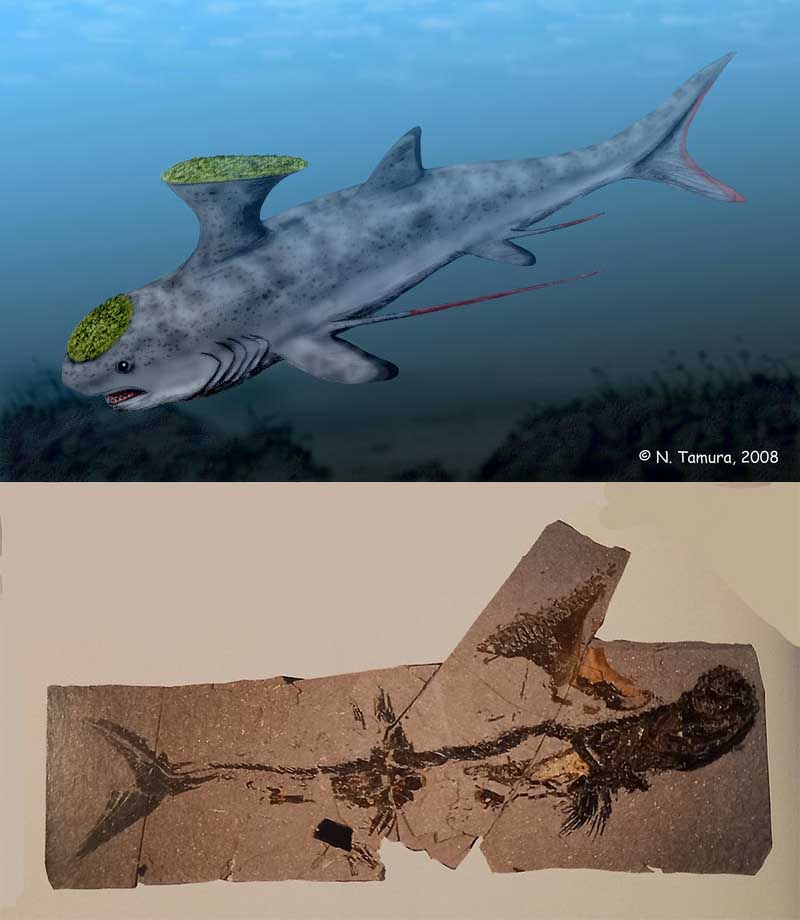
The purpose of this “anvil fin” has been a subject of intense debate. One theory is that it was used in mating rituals, perhaps as a display to attract females, much like a peacock’s tail. Another theory suggests it could have been used for intimidation, making the shark appear larger or more threatening to potential predators or rivals.
To make it even stranger, the top of the shark’s head was also covered in a patch of these same rough denticles. Some scientists have speculated that the shark might have been able to attach itself to larger animals or even the sea floor. Whatever its purpose, Stethacanthus shows that prehistoric sharks were far from being simple killing machines; they were complex animals with unique and specialized features.
The Scissor-Toothed Shark: Edestus
Imagine a shark whose teeth grew in a single row and never fell out, instead being pushed forward by new teeth until they jutted out from the mouth like a pair of grotesque shears. That was Edestus, the “scissor-toothed shark.” This predator, which lived during the Carboniferous period, had one of the most unusual dental arrangements in history.
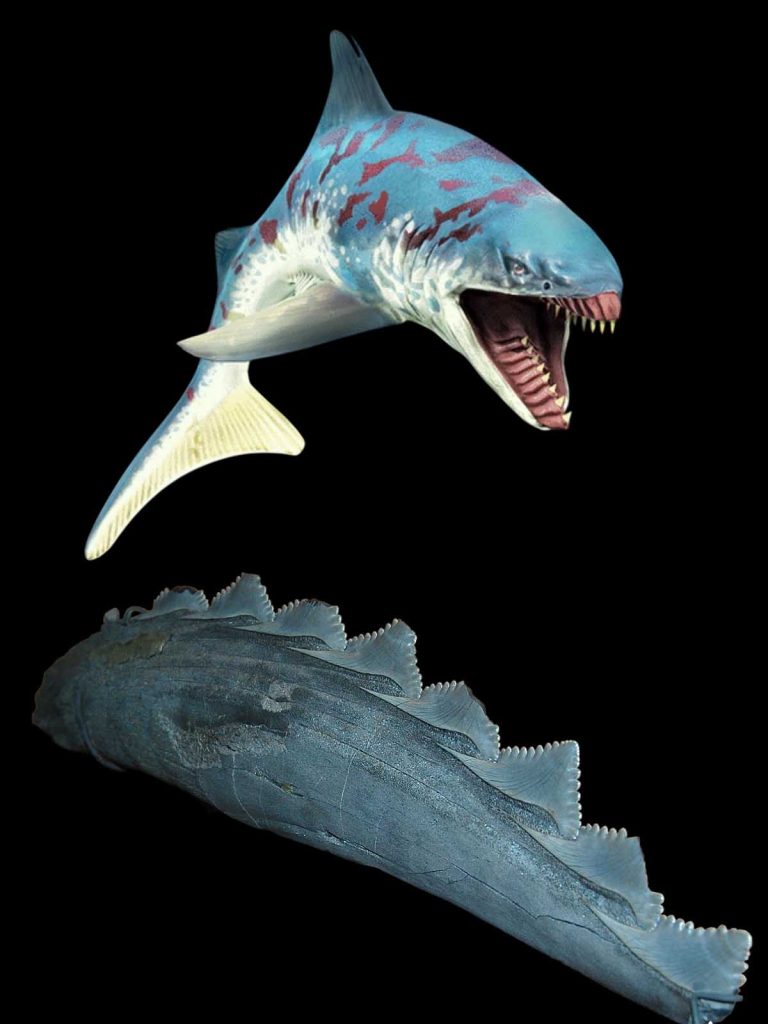
Unlike other sharks, Edestus did not shed its teeth. Its curved rows of teeth, one on the upper jaw and one on the lower, grew straight out from its mouth. Paleontologists believe it hunted by slashing its prey, likely large fish, with a vertical whipping motion of its head, using its bizarre jaws to inflict catastrophic injuries.
Finding a complete fossil of Edestus is extremely rare, and like Helicoprion, its biology is mostly understood from its strange jaw fossils. It serves as another powerful reminder that the evolutionary history of sharks is filled with incredible and sometimes terrifying diversity.
The Ancient Survivor: Cladoselache
Let’s travel even further back in time to meet one of the earliest well-understood sharks, Cladoselache. This shark, which lived over 380 million years ago during the Devonian period, provides a fascinating look at the early stages of shark evolution. Fossils of Cladoselache are remarkably well-preserved, sometimes including impressions of skin, muscle fibers, and even internal organs.
An illustration of the streamlined, torpedo-shaped body of Cladoselache.
Cladoselache provides a window into the early evolution of sharks.
Cladoselache looked more streamlined and torpedo-shaped than many modern sharks. It had a mouth at the front of its snout, rather than underslung like a Great White’s, and its teeth were smooth-edged, not serrated, suggesting it grabbed prey and swallowed it whole. It was a fast and agile hunter of the ancient seas.
Studying Cladoselache helps scientists understand the foundational blueprint of sharks. It shows which features, like the cartilaginous skeleton and multiple gill slits, are ancient and which, like serrated teeth and underslung jaws, evolved much later. It is a key piece in the puzzle of shark history.
Other Notable Prehistoric Sharks
The world of prehistoric sharks is too vast to cover completely, but here are a few other incredible predators worth knowing:
- Cretoxyrhina (The Ginsu Shark): A large, fast shark from the Cretaceous period, its incredibly sharp, seven-centimeter-long teeth earned it the nickname “Ginsu shark” after the famous knives. It was a top predator that hunted marine reptiles like mosasaurs.
- Hybodus: A true survivor, this shark genus lived for over 100 million years, from the Permian to the Cretaceous. It was a versatile generalist, with two types of teeth: sharp ones for catching fish and flat ones for crushing shells.
- Ptychodus: This massive shark had a mouth filled with huge, flat, pavement-like teeth designed for crushing the shells of giant clams and other hard-bodied invertebrates. It was a specialized feeder that grew to over 30 feet long.
- Xenacanthus: An unusual-looking shark that lived in freshwater swamps. It had an eel-like body, a long spine protruding from the back of its head, and distinctively V-shaped teeth.
Why Did Prehistoric Sharks Go Extinct?
While sharks as a group are incredible survivors, many of the prehistoric species we’ve discussed eventually died out. There is no single reason for their extinction; rather, it was often a combination of environmental pressures. For giants like Megalodon, global cooling and a drop in sea levels likely restricted their habitats and led to the decline of their primary food source, large whales.
An artist’s depiction of a mass extinction event in the ocean.
Climate change and the loss of food sources were major drivers of extinction for many prehistoric sharks.
For other species, competition from new predators, like the rise of marine mammals, may have played a role. Mass extinction events, like the one that wiped out the dinosaurs, also claimed many shark species. The sharks that survived were often the smaller, more adaptable species that could survive in a wider range of environments and on a more varied diet.
The story of their extinction is a crucial reminder of how even the most dominant predators are vulnerable to changes in their ecosystem. It underscores the delicate balance of life in our planet’s oceans.
The Enduring Legacy of Ancient Sharks
The prehistoric sharks may be gone, but their legacy lives on. They were pioneers of evolution, developing adaptations that are still used by their modern descendants today. The story of these ancient predators is a story of survival, innovation, and dominance on a scale that is difficult to comprehend.
An image showing the evolutionary tree of sharks, from ancient ancestors to modern species.
The legacy of prehistoric sharks lives on in the diverse shark species of today.
From the sheer power of Megalodon to the bizarre beauty of Helicoprion and Stethacanthus, these animals challenge our understanding of what a shark can be. They are a testament to the incredible creativity of nature and a reminder of the amazing life that once inhabited our planet’s oceans. The next time you see a shark, remember that you are looking at a member of a family that has ruled the seas for over 400 million years.
For more on ancient life, check out our article on The Rise of the Mammals. To learn more about the world these sharks lived in, visit the Natural History Museum’s online exhibits.
Prehistoric Shark Quiz
How much do you know about the ancient rulers of the sea?

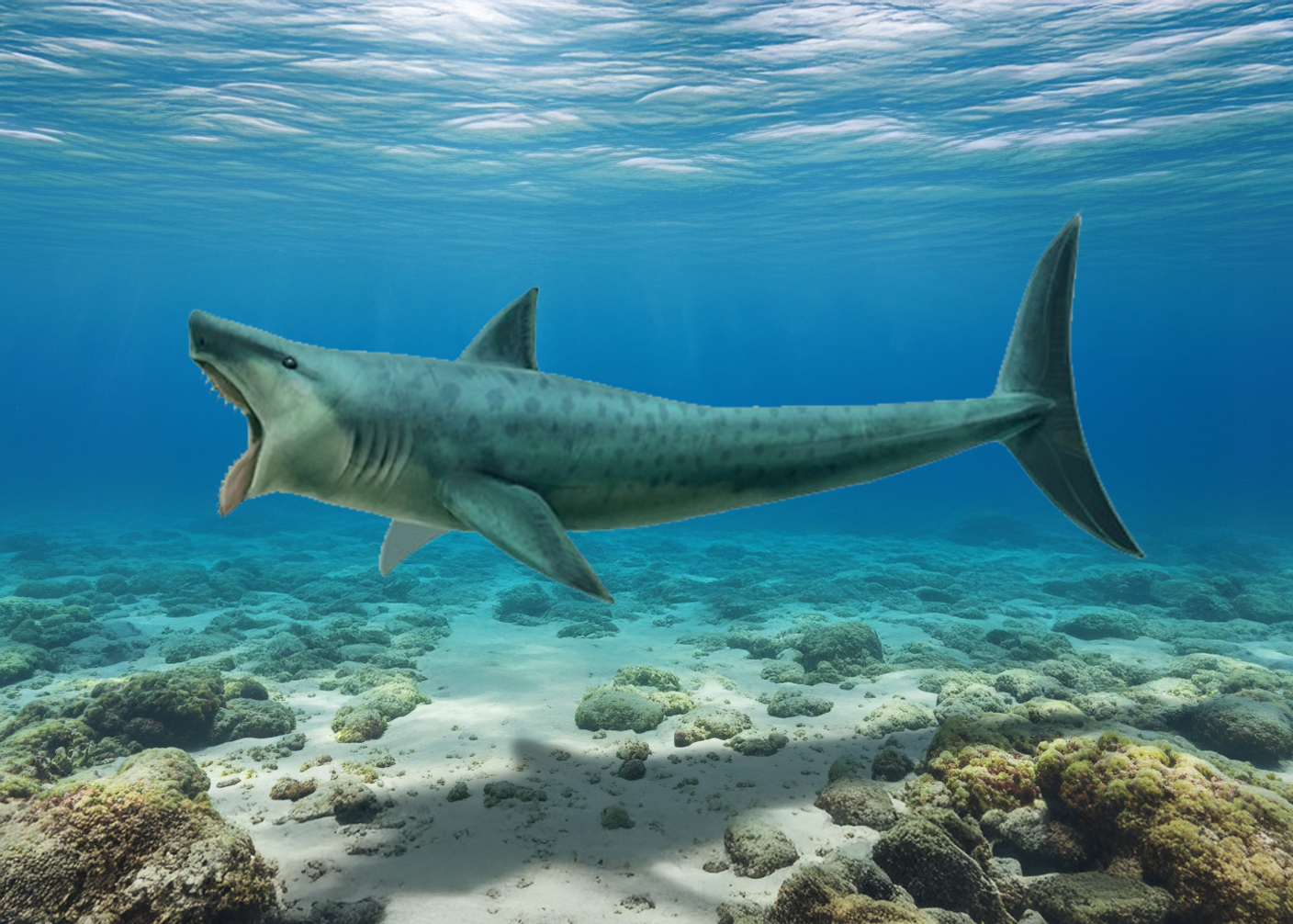
Leave a Reply